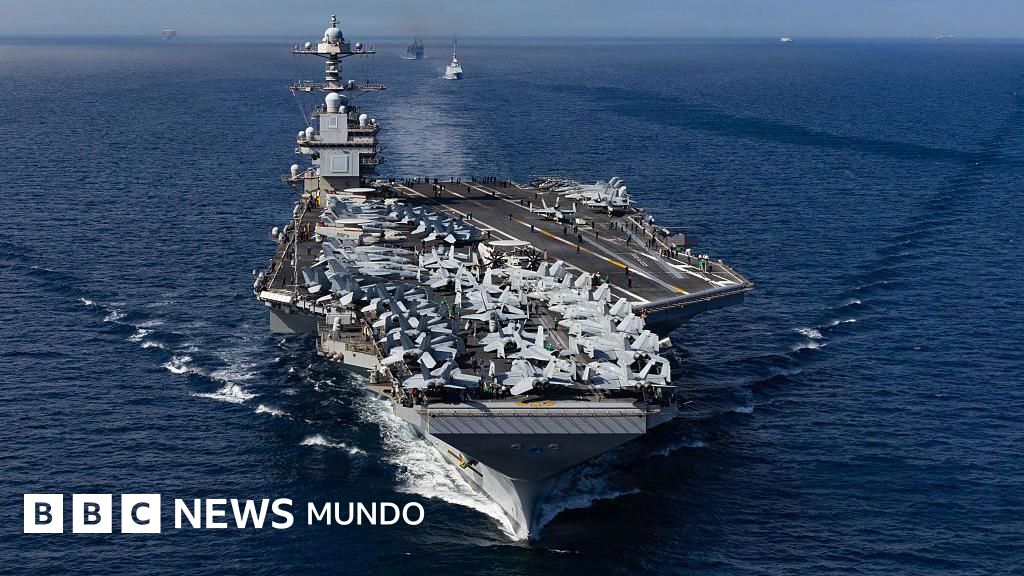
image source, Getty Images
The U.S. naval force deployed in the Caribbean off the coast of Venezuela has received significant reinforcements.
On Tuesday, the Southern Command announced that the aircraft carrier Gerald R. Ford had entered its jurisdiction and would soon join a fleet Washington has deployed south to disrupt drug trafficking from South America and fight the organizations profiting from that business, according to the White House.
Among these gangs, the Trump administration has named the Sunshine Cartel, which it says is made up of military and Venezuelan government officials.
The arrival of the world’s largest warship “strengthens the United States’ ability to detect, monitor, and deter illegal actors and activities that undermine our nation’s security and prosperity,” Pentagon spokesman Sean Parnell said.
The U.S. military has so far attacked 19 suspected drug vessels in both the Caribbean and the Pacific, killing more than 70 people.
Meanwhile, the Venezuelan government has questioned the anti-drug doctrine and believes the military mobilization is part of an operation to remove him from office.
President Nicolas Maduro has declared in recent days that “everything that is being done to Venezuela is to justify war, regime change, and the theft of our vast oil wealth.”
But what is the USS Gerald R. Ford aircraft carrier and what does it take to deploy it?

image source, Samuel Corum/AFP via Getty Images
“The deadliest combat platform”
The U.S. Navy says on its website that the USS Gerald R. Ford is “the world’s most capable, adaptable, and lethal combat platform,” and is the first new aircraft carrier in more than 40 years.
The ship, which began construction in 2007 and was completed in 2013, will serve as a floating airbase and is the first of a new generation of ships powered by nuclear energy, capable of remaining at sea for up to 20 years without the need for refueling.
The ship can carry up to 90 aircraft, including F-35 and F/A-18E/F Super Hornet attack fighters, E-2D Hawkeye reconnaissance aircraft, EA-18G Growler electronic attack aircraft, MH-60R/S helicopters, unmanned aerial vehicles and combat vehicles.
According to the US Navy’s website, the so-called “supercarrier” is 337 meters long and 78 meters wide, making it slightly larger than its so-called Nimitz-class predecessor, which was 333 meters long and 76 meters wide.
However, its dimensions make it the largest warship on Earth today.

image source, Jayme Reyna/AFP via Getty Images
Despite her large size, the USS Gerald R. Ford carries between 4,500 and 5,000 uniformed personnel, a reduction of approximately 25 percent from her predecessor, which required up to 6,000 personnel to operate.
Similarly, the aircraft carrier has a series of innovations that go beyond explaining why its budget has soared from the originally planned US$10 billion to US$13 billion.
Because of this, it not only received the title of the most expensive ship, but also delayed its departure for several years.
The ship was not delivered to the Navy until 2017, four years after it was launched, but did not officially join the fleet until April 2023, when it completed war training and had to return to the shipyard to adjust new systems, the journal said. naval technology.
Mark Cancian, a retired US Marine Corps colonel and research fellow at the Center for Strategic and International Studies (CSIC), told BBC Mundo: “The Ford-class aircraft carriers have several improvements over the previous Nimitz-class carriers, primarily a new catapult system for the aircraft, more powerful radars, and reduced crew size through automation.”

image source, Jonathan Klein/AFP via Getty Images
more takeoffs and landings
The floating fortress was named after the 38th president of the United States, who took office on August 9, 1974, following the resignation of his predecessor, Richard Nixon, due to the Watergate scandal.
The boat can travel at around 30 knots (56 kilometers per hour), which is a similar speed to its predecessor. But it is during the aircraft’s takeoff that the record is broken, and that is thanks to EMALS (Electromagnetic Aircraft Launch System).
EMALS is a new catapult that uses a linear induction motor to generate a magnetic field to move a moving trolley to which the airplane is attached.
Unlike traditional catapults that use pressurized steam, the new system not only launches planes every 45 seconds, 25 percent faster than steam catapults, but also allows heavier aircraft to be launched over shorter distances, lawyer and former U.S. Air Force pilot Harrison Kass said in the article.
“EMALS is being presented as an innovative system that will change naval aviation,” added the now defense affairs expert.

image source, VCG (via Getty Images)
USS Gerald R. Ford’s new catapult has another benefit: it can launch drones.
“Steam catapults have several drawbacks, perhaps the most notable being their tendency to be too powerful, which can damage aircraft and shorten their lifespan,” he explained.
“This overpower problem prevents light aircraft from being launched. Only heavy aircraft such as the F-18 Hornet and E-2 Hawkeye can be launched. This excludes the new unmanned aircraft that the Navy will increasingly rely on in the future,” the former pilot concluded.
President Donald Trump criticized the system as “expensive” and inefficient, but China copied it and installed it on its state-of-the-art aircraft carrier Fujian.

image source, US Navy (via Getty Images)
armed to the teeth
But in addition to carrying dozens of fighter jets that can fire missiles at targets hundreds of miles away, the USS Gerald R. Ford also carries other weapons.
“The carrier also carries early warning aircraft, aerial refueling aircraft, anti-submarine fighters, cargo transport aircraft and electronic warfare aircraft,” Cancian explained.
Furthermore, the ship does not act alone, but is part of a strike group consisting of other warships.
“Their escort ships, in this case probably three destroyers, can not only protect the carrier, but also attack ground targets with long-range Tomahawk missiles,” the veteran added.
“The aircraft carrier Gerald R. Ford is considered the crown jewel of the US Navy, and together with its destroyers (including a destroyer type that can fire guided missiles), it forms the most powerful strike group in the Navy,” Carlos Solar, a Latin American security expert at Britain’s Royal United Services Institute (RUSI), told BBC Mundo.

image source, Monica Hess/U.S. Navy/AFP via Getty Images
intention
The message sent by Washington regarding the ship’s operations in the Caribbean did not specify its specific purpose.
President Trump denied in September that he had met with government officials to study “regime change” in Venezuela, but weeks later publicly announced that he had ordered the Central Intelligence Agency (CIA) to carry out operations in South America.
The U.S. fleet in the Caribbean currently has 170 Tomahawks, according to CSIC, which is more than the U.S. had in the Mediterranean when it attacked Libyan leader Muammar Gaddafi’s regime in 2011.
“This is the first time that an aircraft carrier will conduct an anti-narcotics operation. However, it is unlikely to play a big role there, as its capabilities are not well suited for that type of mission. Rather, I think it could be used to launch an attack against Venezuela,” Cancian speculates.
The Tomahawks carried by U.S. warships have a range of up to 1,600 kilometers and can reach targets in almost all parts of the South American country.

image source, Federico Parra/AFP via Getty Images
“Together with Southern Command units already deployed in the Caribbean, the Ford Strike Group represents a fighting force unparalleled in the past decade for military operations in the Western Hemisphere,” Solar added.
Basil Jarmond, professor of international security at Lancaster University in the UK, agreed: “Aircraft carriers are not normally involved in counter-narcotics operations at sea, because they are expensive to operate and their primary purpose is high-level combat missions.”
However, he told BBC Mundo he did not rule out the possibility of Ford or some of its escorts taking part in these missions, which “require maritime knowledge”.
However, a professor at the Royal Naval Strategic Research Center argued that the ship’s presence in the area was a political message.
“Aircraft carriers are symbols of power and demonstrate political resolve. We call this naval diplomacy. Deploying aircraft carriers can help coerce other actors without actually resorting to force.”
“Whatever message the Trump administration wants to send, it’s communicating it in a very powerful and credible way,” he concluded.

Subscribe here Sign up for our new newsletter and we’ll bring you the week’s best content every Friday.
Don’t forget that you can also receive notifications in the app. Please download and activate the latest version.



